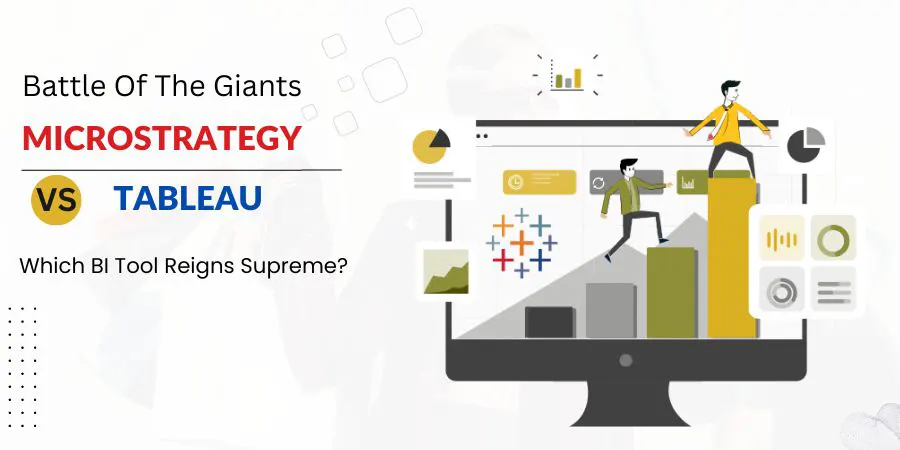
In the world of business intelligence tools, MicroStrategy and Tableau are two prominent players that have garnered a significant following. Both tools offer robust features and capabilities to help firms derive valuable insights from their data. It is widely acknowledged and accepted that both platforms possess distinct capabilities and inherent limitations. To ascertain a definitive advantage, we have undertaken a comprehensive examination of their respective features and disparities.
Overview Of MicroStrategy:
MicroStrategy is a comprehensive enterprise-level BI platform that offers a distinct range of functionalities for data visualization, reporting, and analytics. It boasts a strong reputation for its scalability, security, and performance. The primary features of MicroStrategy include:
- Unified Platform: MicroStrategy offers a unified platform that encompasses data discovery, advanced analytics, mobile analytics, and enterprise reporting. It offers a centralized environment for all BI activities, simplifying data management and governance.
- Robust Analytics: MicroStrategy's analytics capabilities include ad hoc querying, data blending, data mining, predictive analytics, and statistical modeling. It empowers users to uncover patterns, trends, and relationships within their data to make data-driven decisions.
- Enterprise-Grade Security: MicroStrategy places a strong emphasis on security, offering features such as role-based access control, data encryption, and integration with external security systems. It is an ideal option for firms that deal with sensitive and confidential data.
- Scalability: MicroStrategy is designed to handle large volumes of data and supports high user concurrency. It can seamlessly integrate with distinct data sources, including traditional databases, big data platforms, and cloud-based systems.
- Governance And Administration: MicroStrategy provides comprehensive governance and administration features, permitting administrators to manage users, security, and data access. It also facilitates data lineage, auditing, and version control, ensuring data integrity and compliance.
While MicroStrategy offers powerful features, it may have a steeper learning curve and require dedicated IT resources for implementation and maintenance. However, its enterprise-grade capabilities make it an ideal option for large firms with complex BI requirements.
Overview Of Tableau:
Tableau software consulting is a valuable service that leverages the capabilities of Tableau, a leading self-service BI tool known for its user-friendly interface and powerful data visualization capabilities. It enables users to construct interactive and visually appealing dashboards and reports with ease. The primary features of Tableau are:
- Intuitive Data Visualization: Tableau's strength lies in its intuitive drag-and-drop interface, which permits users to construct compelling visualizations without the need for complex coding. It offers a distinct variety of charts, graphs, and maps to effectively represent data.
- Self-Service Analytics: Tableau empowers business users to perform ad hoc analysis and explore data on their own. It provides features like data blending, calculated fields, and quick filters, enabling users to derive insights without relying heavily on IT or data professionals.
- Interactive Dashboards: Tableau permits users to construct highly interactive dashboards with dynamic filters, drill-down options, and interactive tooltips. It enhances user engagement and boosts data exploration at distinct levels of granularity.
- Data Connectivity: Tableau provides extensive connectivity options, permitting users to connect to distinct data sources, including spreadsheets, databases, cloud services, and web-based connectors. It supports both live connections and data extracts for optimized performance.
- Community And Sharing: Tableau has a vibrant user community, offering a wealth of resources, tutorials, and pre-built visualizations. It facilitates sharing and collaboration, permitting users to publish and share dashboards with others for viewing and analysis.
Tableau's ease of use and visually appealing outputs make it ideal for business users and analysts. However, it may not offer the same level of enterprise scalability and security as MicroStrategy, which could be a consideration for larger organizations.
Comparing MicroStrategy And Tableau:
Now, let's compare MicroStrategy and Tableau across several primary aspects to comprehend their differences and determine which tool comes out on top:
- Scalability: MicroStrategy is known for its scalability, making it ideal for large firms with high data volumes and user concurrency. Tableau, while scalable, may face limitations in handling extremely large datasets or high user loads.
- Analytics Capabilities: MicroStrategy offers a broader range of advanced analytics features, including data mining, predictive analytics, and statistical modeling. Tableau focuses more on data visualization and predictive analytics, making it a user-friendly tool for business users.
- Ease Of Use: Tableau's intuitive interface and drag-and-drop functionality makes it a highly user-friendly tool. MicroStrategy, on the other hand, may have a steeper learning curve due to its extensive capabilities and enterprise-grade features.
- Security And Governance: MicroStrategy's emphasis on security and governance features makes it an ideal firm for firms with strict compliance requirements. Tableau offers basic security features but may require additional measures to meet enterprise-level security standards.
- Community And Ecosystem: Tableau has a thriving community and ecosystem, with a vast library of pre-built visualizations, tutorials, and extensions. MicroStrategy also has an active user community but may have a smaller ecosystem compared to Tableau.
- Pricing: Both MicroStrategy and Tableau offer distinct pricing models based on factors like user licenses, functionality, and deployment options. The pricing structure may vary, making it essential to evaluate costs based on specific requirements.
Conclusion:
Choosing between MicroStrategy and Tableau ultimately depends on your organization's specific needs, priorities, and resources. MicroStrategy is a robust enterprise-level BI platform that excels in scalability, security, and advanced analytics. It is well-suited for large firms that require comprehensive governance and data management capabilities.
Tableau, on the other hand, shines with its user-friendly interface, self-service analytics, and visually appealing dashboards. It empowers business users to explore and visualize data without heavy reliance on IT or data professionals.
Ultimately, the ideal BI tool for your firm will depend on factors such as the complexity of your data environment, the level of advanced analytics required, the technical expertise of users, and the organization's budget.
Consider conducting a thorough evaluation, including trials and demos, and engaging with vendor representatives to comprehend how each tool aligns with your specific requirements.
Remember, the ideal BI tool is the one that best meets your firm's needs and enables you to derive actionable insights from your data.